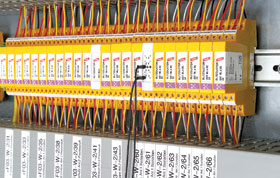Preventing false alarms caused by lightning strikes and surges
February 2015
Electrical Power & Protection

The function of emergency alarm systems, albeit fire or burglar, is to produce an alarm in the event of danger and to remain passive when there is none. The malfunction of these systems, either no alarm sounding if there is danger or an alarm sounding unnecessarily, is not just a nuisance; it can also be dangerous and can result in expensive call-out fees.
False alarms have the following consequences:
• Security personnel start ignoring the alarm messages.
• Neighbours are disturbed by acoustic alarms.
• Emergency staff is unnecessarily called out.
• The triggering of fire extinguishing systems can cause interruption of operations.
All these factors cause unnecessary costs and can be prevented if possible causes of false alarms are recognised at an early design stage and are eliminated by taking suitable preventive measures. Lightning strikes are one such cause, and given the profusion of summer storms in South Africa, this is a real threat. And with many businesses closing over the December holiday, ask yourself: do you want to be called back if your property experiences a false alarm? Coordinated lightning and surge protection prevents false alarms or the destruction by atmospheric discharges or switching over voltages and increases the availability of the systems.
Many of today’s emergency alarm systems have an increased immunity to transients on the primary lines, secondary lines and mains voltage cables according to IEC 61000-4-5. Nevertheless, only external and internal lightning protection measures provide comprehensive protection against damage resulting from lightning strikes and surges.
Monitoring principles
Different monitoring principles are used for emergency alarm systems:
• Pulse polling technology: Information from the sensor which has triggered the alarm is digitally transmitted. This allows the identification of the sensor and its exact location.
• DC circuit technology: According to the closed circuit principle, every alarm line is permanently monitored. If a sensor in a line is triggered, the line is interrupted and an alarm is produced in the alarm panel. However, only the alarm line, but not the individual sensor can be identified.
Irrespective of the monitoring principle used, all cables extending between the different areas of the emergency alarm system must be integrated in the lightning and surge protection concept of the overall system.
Recommended protection
Dehn’s Blitzductor XT, type BXT ML2 BE, must be installed to protect two-wire alarm lines and connect the earth drain wire by means of an EMC spring terminal. For cables with more than two wires, a four-wire version, BXT ML4 BE, is available. Surge protective devices are selected according to the voltage of the alarm lines, which is typically between 12 and 48 V. The low internal resistance is also a clear advantage of Blitzductor arresters since the maximum resistances of the alarm lines must not be exceeded. For the outputs of the alarm panels (acoustic and visual) it must be ensured that the nominal current of the surge protective devices is not exceeded.
For more information contact Alexis Barwise, Dehn Protection South Africa, +27 (0)11 704 1487, [email protected], www.dehn-africa.com
Further reading:
Hitachi Energy’s power quality solution
Electrical Power & Protection
Hitachi Energy has announced the deployment of its power quality solution to connect Tanzania’s leading gold producer, Geita Gold Mine (GGML) securely to the national grid.
Read more...
Rail electrification and EV solutions for integrated transport systems
Electrical Power & Protection
A comprehensive range of solutions for rail electrification and electric vehicles is available from leading technology provider ABB, contributing significantly to integrated and sustainable transport systems.
Read more...
PPS delivers containerised distribution board for Western Cape hybrid power project
Electrical Power & Protection
South African electrical enclosure specialist Power Process Systems has successfully completed the design, fabrication and commissioning of a 4000 A containerised distribution board for a wind/PV solar hybrid renewable energy project on a site in the Western Cape.
Read more...
The choice of a thermal carrier is critical for optimal processing
Electrical Power & Protection
Historically steam, fuelled by coal, has been the most prevalent thermal carrier in South African industry. However, times are changing, with the manufacturing and processing sector needing to review the energy reticulation systems and thermal carriers currently in use.
Read more...
ABB’s blueprint for a net zero future
Electrical Power & Protection
ABB’s Mission to Zero is a strategic initiative aimed at achieving a sustainable future characterised by zero emissions, zero accidents and zero waste.
Read more...
How South Africa’s transformer manufacturing industry can fill a gaping infrastructure gap
ACTOM Electrical Machines
Electrical Power & Protection
South Africa’s energy transition is accelerating the demand for power transformers. However, this shift toward renewable energy is exposing a critical infrastructure gap: a severe shortage of transformers.
Read more...
General-purpose 350 W AC-DC power supply
Electrical Power & Protection
The TDK-Lambda GUS350 series of compact single-output general-purpose power supplies addresses the need for an economically priced product while maintaining reliability and quality.
Read more...
Ground-breaking battery tester
Comtest
Electrical Power & Protection
Midtronics offers the proven MVT handheld battery tester. This revolutionary tool, powered by MDX-AI, is set to redefine the standards of battery diagnostics and testing in the automotive industry.
Read more...
Green hydrogen could be the missing link in powering the future of technology
Electrical Power & Protection
Green hydrogen has numerous applications across multiple industries. It also has the potential to provide a clean energy source to power future technology, with far-reaching implications for both industry and society.
Read more...
Energy audits pave the pathway to sustainability and savings
Schneider Electric South Africa
Electrical Power & Protection
Energy audits serve as essential tools for businesses looking to reduce costs and meet environmental targets. By analysing energy consumption across systems such as lighting, HVAC, ICT and water infrastructure, audits identify inefficiencies and quantify carbon footprints, enabling data-driven decisions for operational and financial optimisation.
Read more...


